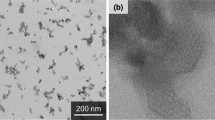Morphological analysis of the respiratory tract of Wistar rats was performed after a single parenteral administration of 12-nm silicon dioxide nanoparticles (1 ml, 2 mg/ml, intravenously) was performed. On day 21 and in 2, 4, and 6 months after the administration of nanoparticles, the development of macrophage infiltration in the interstitium of the respiratory tract was demonstrated by histological and immunohistochemical methods. The pool of alveolar macrophages increased in 4 months after administration (p=0.004) and returned to the control values in 6 months. The number of mast cells did not significantly change at all stages of the experiment. Connective tissue remodeling in the interstitium of the respiratory tract was not observed throughout the observation period.
Similar content being viewed by others
References
Mil’to IV. Liver, lung, kidney and spleen macrophages in rats after intravenous administration of the modified magnetite nanoparticles. Morfologiya. 2014;146(5):40-45. Russian.
Braakhuis HM, Park MV, Gosens I, De Jong WH, Cassee FR. Physicochemical characteristics of nanomaterials that affect pulmonary inflammation. Part. Fibre Toxicol. 2014;11:18. https://doi.org/10.1186/1743-8977-11-18
Carlander U, Li D, Jolliet O, Emond C, Johanson G. Toward a general physiologically-based pharmacokinetic model for intravenously injected nanoparticles. Int. J. Nanomedicine. 2016;11:625-640.
Chan WT, Liu CC, Chiang Chiau JS, Tsai ST, Liang CK, Cheng ML, Lee HC, Yeung CY, Hou SY. In vivo toxicologic study of larger silica nanoparticles in mice. Int. J. Nanomedicine. 2017;12:3421-3432.
Croissant JG, Brinker CJ. Biodegradable silica-based nanoparticles: dissolution kinetics and selective bond cleavage. Enzymes. 2018;43:181-214.
Gardai SJ, Xiao YQ, Dickinson M, Nick JA, Voelker DR, Greene KE, Henson PM. By binding SIRPalpha or calreticulin/CD91, lung collectins act as dual function surveillance molecules to suppress or enhance inflammation. Cell. 2003;115(1):13-23.
Gongalsky M, Gvindzhiliia G, Tamarov K, Shalygina O, Pavlikov A, Solovyev V, Kudryavtsev A, Sivakov V, Osminkina LA. Radiofrequency hyperthermia of cancer cells enhanced by silicic acid ions released during the biodegradation of porous silicon nanowires. ACS Omega. 2019;4(6):10,662-10,669.
Jessop F, Hamilton RF Jr, Rhoderick JF, Fletcher P, Holian A. Phagolysosome acidification is required for silica and engineered nanoparticle-induced lysosome membrane permeabilization and resultant NLRP3 inflammasome activity. Toxicol. Appl. Pharmacol. 2017;318:58-68.
Lambrecht BN. Alveolar macrophage in the driver’s seat. Immunity. 2006;24(4):366-368.
Leclerc L, Rima W, Boudard D, Pourchez J, Forest V, Bin V, Mowat P, Perriat P, Tillement O, Grosseau P, Bernache-Assollant D, Cottier M. Size of submicrometric and nanometric particles affect cellular uptake and biological activity of macrophages in vitro. Inhal. Toxicol. 2012;24(9):580-588.
Lepekha LN, Alexandrova EA, Erokhina MV. In vitro effects of pulmonary surfactant on macrophage morphology and function. Bull. Exp. Biol. Med. 2012;152(4):489-493.
Lewis DJ, Williams TC, Beck SL. Foamy macrophage responses in the rat lung following exposure to inhaled pharmaceuticals: a simple, pragmatic approach for inhaled drug development. J. Appl. Toxicol. 2014;34(4):319-331.
Li H, Wu X, Yang B, Li J, Xu L, Liu H, Li S, Xu J, Yang M, Wei M. Evaluation of biomimetically synthesized mesoporous silica nanoparticles as drug carriers: Structure, wettability, degradation, biocompatibility and brain distribution. Mater. Sci. Eng. C Mater. Biol. Appl. 2019;94:453-464.
Yang M, Jing L, Wang J, Yu Y, Cao L, Zhang L, Zhou X, Sun Z. Macrophages participate in local and systemic inflammation induced by amorphous silica nanoparticles through intratracheal instillation. Int. J. Nanomedicine. 2016;11:6217-6228.
Author information
Authors and Affiliations
Corresponding author
Additional information
Translated from Byulleten’ Eksperimental’noi Biologii i Meditsiny, Vol. 170, No. 7, pp. 102-105, July, 2020
Rights and permissions
About this article
Cite this article
Yukina, G.Y., Polovnikov, I.V., Sukhorukova, E.G. et al. Morphological Analysis of the Respiratory Tract of Rats after Parenteral Administration of Silicon Dioxide Nanoparticles. Bull Exp Biol Med 170, 93–97 (2020). https://doi.org/10.1007/s10517-020-05011-4
Received:
Published:
Issue Date:
DOI: https://doi.org/10.1007/s10517-020-05011-4



